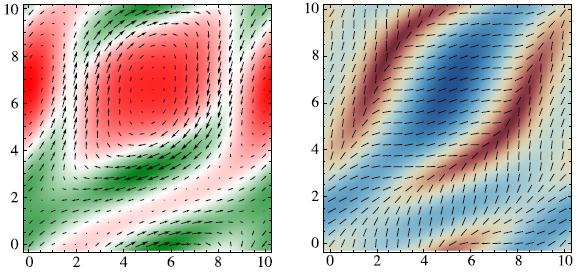Active Matter
Active matter describes systems whose constituent elements consume energy and are thus out-of-equilibrium. Examples include flocks or herds of animals, collections of cells, and components of the cellular cytoskeleton.
When these objects interact with each other, collective behavior can emerge that is unlike anything possible with an equilibrium system. The types of behaviors and the factors that control them however, remain incompletely understood for most systems. Our group has worked to develop and apply theoretical and computational descriptions of several model active systems.
Example Active Matter Systems

Fig. 1. Left: A flock of starlings exhibits collective motion. Center: A bacterial suspension exhibits collective flow and characteristic defect patterns. Right: A suspension of microtubules studied in the Dogic Lab at Brandeis.
- Preliminary experiments on active microtubule suspensions from the Dogic lab showed massive spatial fluctuations in density and nematic order, which could not be described by existing theoretical descriptions of active nematics. To begin understanding these experiments, we applied an active hydrodynamic theory which does account for spatiotemporal variations in the magnitude of the nematic order parameter. The theory predicts that the interplay between non-uniform nematic order, activity and flow results in spatially modulated relaxation oscillations, similar to those seen in excitable media and biological systems such as the cardiac cycle. At even higher activity the dynamics is chaotic. [1, 2]

Fig. 2: The system behavior for an active nematic at high activity. (left) The velocity field (arrows) is superimposed on a plot of the concentration of active nematogens (green=large concentration, red=small concentration). (right) A plot of the nematic order parameter, S, (blue=large S, brown=small S) is superimposed on a plot of the nematic director (arrows). The flow under high activity is characterized by large vortices that span lengths of the order of the system size and the director field is organized in grains. Figure is from [2]
- Mixed active/passive systems. Inevitably, some members of an active system break, die, or never acquire activity, and thus it is important to characterize emergent behavior in mixtures of active and inactive particles. In collaboration with Aparna Baskaran (Brandeis) we investigated the behavior of a mixture of self-propelled and passive rods interacting solely through excluded volume interactions using computation and theory. The system is unstable to demixing, with a rich array of domain structures and dynamics (e.g. Fig. 3). These predictions could be tested with the experiments that monitor collections of motile and non-motile bacteria or self-propelled and passive rods. They may be relevant to biofilm morphology, where motile and non-motile (or dead) bacteria have been shown to segregate. [3]

Fig. 3: Mixtures of active and passive rods segregate [3]. Pictured rods are identical except that red rods are self-propelled while green rods undergo only passive Brownian motion. Snapshots from simulations with different densities and self propulsion speeds are shown, which illustrate three different system behaviors. Movies illustrating the dynamics are available.
- Giomi, L., L. Mahadevan, B. Chakraborty, and M.F. Hagan, Banding, Intermittency and Chaos in Active Nematic Suspensions. arXiv:1110.4338, 2012.
- Giomi, L., L. Mahadevan, B. Chakraborty, and M.F. Hagan, Excitable Patterns in Active Nematics. Physical Review Letters, 2011. 106(21).
- McCandlish, S.R., A. Baskaran, and M.F. Hagan, Spontaneous Segregation of Self-Propelled Particles with Different Motilities. Soft Matter, 2012. in press.